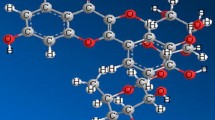Abstract
The corrosion inhibition property of the Uncaria gambir extract (UGE) for the low-carbon steel was investigated in a prepared cooling-water solution using gravimetric analysis and potentiodynamic polarization measurements. Anticorrosive effectiveness was tested at the UGE concentrations of 0–1500 ppm and temperatures of 40–60°C. The CaCO3 scale inhibition performance was evaluated following NACE standard TM 0374-2007 and ASTM D511-03. The surface morphology was analyzed by scanning electron microscopy. It was found that increasing the UGE concentration increased its anticorrosive effectiveness. A 70% corrosion inhibition efficiency and a 31% CaCO3 scale inhibition efficiency were observed during the use of 1500 ppm UGE. A change in the morphology of CaCO3 precipitate was observed due to the adsorption of the UGE, which suppressed the regular growth process. Increasing temperature decreased the effectiveness of the UGE. A higher corrosion potential and a reduction of anodic reactivity were also observed. The UGE acted as anodic inhibitor and conformed the Langmuir adsorption isotherm.









Similar content being viewed by others
REFERENCES
Herro, H.M. and Port, R.D., The Nalco Guide to Cooling Water Systems Failure Analysis, New York: McGraw-Hill, 1993.
Seneviratne, M., Cooling Water Systems: A Practical Approach to Water Conservation for Commercial and Industrial Facilities, Amsterdam: Elsevier, 2006.
Ash, M. and Ash, I., Handbook of Corrosion Inhibitors, New York: Synapse Inf. Resour., 2001.
Choi, D.J., You, S., and Kim, J.G., Mater. Sci. Eng., A, 2002, vol. 335, nos. 1–2, pp. 228–235.
Minhaj, A., Saini, P.A., Quraishi, M.A., and Farooqi, I.H., Corros. Prev. Control, 1999, vol. 46, no. 2, pp. 32–38.
Abdel-Gaber, A.M., Abd-El-Nabey, B.A., Khamis, E., and Abd-El-Khalek, D.E., Desalination, 2011, vol. 278, pp. 337–342.
Bouyanzer, A. and Hammouti, B., Bull. Electrochem., 2004, vol. 20, pp. 63–65.
Eddy, N.O., Int. J. Phys. Sci., 2009, vol. 4, pp. 165–171.
Quraishi, M.A., Farooqi, I.H., and Saini, P.A., Corrosion, 1999, vol. 55, no. 5, pp. 493–497.
Halambek, J., Berković, K., and Vorkapić-Furač, J., Mater. Chem. Phys., 2013, vol. 137, no. 3, pp. 788–795.
Liao, L.L., Mo, S., Luo, H.Q., and Li, N.B., J. Colloid Interface Sci., 2017, vol. 499, pp. 110–119.
El-Etre, A.Y., Abdallah, M., and El-Tantawy, Z.E., Corros. Sci., 2005, vol. 47, no. 2, pp. 385–395.
Sathiyanathan, R.A.L., Maruthamuthu, S., Selvanayagam, M., Mohanan, S., et al., Indian J. Chem. Technol., 2005, vol. 12, pp. 356–360.
Wongkramprai, P. and Jariyaboon, M., Anti-Corros. Method Mater., 2016, vol. 63, no. 6, pp. 470–476.
Abdel-Aal, N. and Sawada, K., J. Cryst. Growth, 2003, vol. 256, nos. 1–2, pp. 188–200.
Kitamura, M., J. Colloid Interface Sci., 2000, vol. 236, pp. 318–327.
Matthias, G. and Thomas, M., Desalination, 2006, vol. 199, pp. 26–28.
Abdullah Dar, M., Ind. Lubr. Tribol., 2011, vol. 63, no. 4, pp. 227–233.
Hussin, M.H. and Kassim, M.J., Mater. Chem. Phys., 2011, vol. 125, pp. 461–468.
Hussin, M.H. and Kassim, M.J., J. Phys. Sci., 2010, vol. 21, no. 1, pp. 1–14.
Hsieh, M.K., Dzomback, D.A., and Vidic, R.D., Ind. Eng. Chem. Res., 2010, vol. 49, no. 19, pp. 9117–9123.
TM0374-2016, Laboratory Screening Tests to Determine the Ability of Scale Inhibitors to Prevent the Precipitation of Calcium Sulfate and Calcium Carbonate from Solution (for Oil and Gas Production Systems), Houston, TX: NACE Int., 2016.
ASTM D511-03: Standard Test Methods for Calcium and Magnesium in Water, West Conshohocken, PA: ASTM Int., 2003.
Ehteram, N.A., J. Appl. Electrochem., 2009, vol. 39, pp. 1465–1475.
Wan Nik, W.B., Zulkifli, F., Rosliza, R., and Rahman, M.M., Int. J. Res. Mod. Eng. Emerg. Technol., 2011, vol. 1, no. 2, pp. 723–728.
Radojčić, I., Berković, K., Kovac, S., and Vorkapić-Furač, J., Corros Sci., 2008, vol. 50, no. 5, pp. 1498–1504.
Wang, C., Li, S.P., and Li, T.D., Desalination, 2009, vol. 249, no. 1, pp. 1–4.
ACKNOWLEDGMENTS
The authors would like to thank the Faculty of Science, Mahidol University, Thailand, for the support throughout this research. Jiraphan Pleanteangthume acknowledges a partial support from the Faculty of Science and the Faculty of Graduate Studies, Mahidol University, Thailand.
Author information
Authors and Affiliations
Corresponding author
Ethics declarations
The authors declare that they have no conflict of interest.
About this article
Cite this article
Jiraphan Pleanteangthume, Manthana Jariyaboon Effects of Concentration and Temperature on Corrosion and Scale Inhibitive Behavior of Uncaria gambir Extract for Low-Carbon Steel in Cooling-Water Solution. Surf. Engin. Appl.Electrochem. 56, 746–753 (2020). https://doi.org/10.3103/S1068375520060137
Received:
Revised:
Accepted:
Published:
Issue Date:
DOI: https://doi.org/10.3103/S1068375520060137




